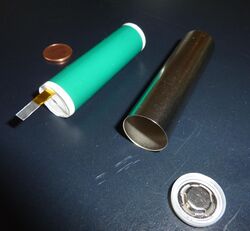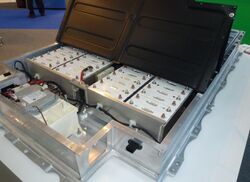Engineering:Environmental impacts of lithium-ion batteries

Lithium batteries are primary batteries that use lithium as an anode. This type of battery is also referred to as a lithium-ion battery[1] and is most commonly used for electric vehicles and electronics.[2] The first type of lithium battery was created by the British chemist M. Stanley Whittingham in the early 1970s and used titanium and lithium as the electrodes. Unfortunately, applications for this battery were limited by the high prices of titanium and the unpleasant scent that the reaction produced.[3] Today's lithium ion battery, modeled after the Whittingham attempt by Akira Yoshino, was first developed in 1985.
Environmental impact
The physical mining of lithium and the production of lithium-ion are both labor-intensive processes. Additionally, most batteries are not properly recycled.[4]
Extraction
Lithium is extracted on a commercial scale from three principal sources: salt brines, lithium-rich clay, and hard-rock deposits. Each method incurs certain unavoidable environmental disruption. Brine extraction (specifically when using evaporation pools to separate lithium from other substances present in the salt flat) is a particularly water-intensive method, using an estimated 500,000 gallons of water to produce one metric ton of lithium.[5] In Chile ,[6] the world's second largest lithium producer, the nation's two active mines, run by SQM and Albemarle, are both located on the Salar de Atacama salt flat in the Atacama Desert.[7] Whilst certain groups and individuals among the local community have raised concerns about the impact of lithium mining on regional water sources, both corporations dispute these assertions, claiming that the brine used in the extraction process is distinct, due to its elevated salinity, from the freshwater systems on which the communities depend. There is a complex divide among and within local communities, with some accepting payouts from the mining corporations and taking part in their community development initiatives, whilst others are either neglected by such programs, or refuse the corporations' offers due to their aforementioned environmental concerns. [8][9] In Tagong, a small town in Garzê Tibetan Autonomous Prefecture China, there are records of dead fish and large animals floating down some of the rivers near the Tibetan mines. After further investigation, researchers found that this may have been caused by leakage of evaporation pools that sit for months and sometimes even years.[10]
Disposal
Lithium-ion batteries contain metals such as cobalt, nickel, and manganese, which are toxic and can contaminate water supplies and ecosystems if they leach out of landfills.[11] Additionally, fires in landfills or battery-recycling facilities have been attributed to inappropriate disposal of lithium-ion batteries.[12] As a result, some jurisdictions require lithium-ion batteries to be recycled.[13] In spite of the environmental cost of improper disposal of lithium-ion batteries, the rate of recycling is still relatively low, as recycling processes remain costly and immature.[14]
Finite resource
While lithium ion batteries can be used as a part of a sustainable solution, shifting all fossil fuel-powered devices to lithium based batteries might not be the Earth's best option. There is no scarcity yet, but it is a natural resource that can be depleted.[15] According to researchers at Volkswagen, there are about 14 million tons of lithium left, which corresponds to 165 times the production volume in 2018.[16]
Recycling
The EPA has guidelines regarding recycling lithium batteries in the U.S. There are different processes for single-use or rechargeable batteries, so it is advised that batteries of all sizes are brought to special recycling centers. This will allow a safer process of breaking down the individual metals that can be reclaimed for further use.[17]
There are currently three major methods used for the recycling of lithium-ion batteries, those being:
Pyrometallurgical recovery
The processes within the pyrometallurgical recovery include pyrolysis, incineration, roasting, and smelting. Right now, most traditional industrial processes are not able to recover lithium. The main process is to extract other metals including cobalt, nickel, and copper. There is a very low recycling efficiency in materials and use of capital resources. There are high energy requirements along with gas treatment mechanisms that will produce a lower volume of gas byproducts.[18]
Hydrometallurgical metals reclamation
Hydrometallurgy is the application of aqueous solution to recover metal from ores. It is commonly used for copper recovery. This method has been used for other metals to help eliminate the problem of sulfur dioxide byproducts that more conventional smelting causes.[19]
Direct recycling
While recycling is an option, it still generally remains being more expensive than mining the ores themselves.[20] With the rising demand for lithium-ion batteries the need for a more efficient recycling program is detrimental with many companies racing to find the most efficient method. One of the most pressing issues is when the batteries are manufactured, recycling is not considered a design priority.[21]
Application
There are many uses for lithium-ion batteries since they are light, rechargeable and are compact. They are mostly used in electric vehicles and hand-held electronics, but are also increasingly used in military and aerospace applications.[22]
Electric vehicles
The primary industry and source of the lithium-ion battery is electric vehicles (EV). Electric vehicles have seen a massive increase in sales in recent years with over 90% of all global car markets having EV incentives in place as of 2019.[23] With this increase in sales of EVs and the continued sales of them we can see a significant improvement to environmental impacts from the reduction of fossil fuel dependencies.[24] There have been recent studies that explore different uses for recycled lithium ion batteries specifically from electric vehicles. Specifically the secondary use of lithium ion batteries recycled from electric vehicles for secondary use in power load peak shaving in China has been proven to be effective for grid companies.[25] With the environmental threats that are posed by spent lithium-ion batteries paired with the future supply risks of battery components for electric vehicles, remanufacturing of lithium batteries must be considered. Based on the EverBatt model, a test was conducted in China which concluded that remanufacturing of lithium-ion batteries will only be cost effective when the purchase price of spent batteries remains low. Recycling will also have significant benefits to environmental impacts. In terms of greenhouse gas reduction we see a 6.62% reduction in total GHG emissions with the use of remanufacturing.[26]
See also
- Aluminium-ion battery
- Glass battery
- Lithium–sulfur battery
- Potassium-ion battery
- Sodium-ion battery
References
- ↑ Zeng, Xianlai; Li, Jinhui; Singh, Narendra (2014-05-19). "Recycling of Spent Lithium-Ion Battery: A Critical Review" (in en). Critical Reviews in Environmental Science and Technology 44 (10): 1129–1165. doi:10.1080/10643389.2013.763578. ISSN 1064-3389. http://www.tandfonline.com/doi/abs/10.1080/10643389.2013.763578.
- ↑ Zeng, Xianlai; Li, Jinhui; Singh, Narendra (2014-05-19). "Recycling of Spent Lithium-Ion Battery: A Critical Review" (in en). Critical Reviews in Environmental Science and Technology 44 (10): 1129–1165. doi:10.1080/10643389.2013.763578. ISSN 1064-3389. http://www.tandfonline.com/doi/abs/10.1080/10643389.2013.763578.
- ↑ Bottled lightning: superbatteries, electric cars, and the new lithium economy. 2011-11-01.
- ↑ "The Environmental Impact of Lithium Batteries" (in en-US). 2020-11-12. https://www.instituteforenergyresearch.org/renewable/the-environmental-impact-of-lithium-batteries/.
- ↑ Bauer, Sophie (2020-12-02). "Explainer: the opportunities and challenges of the lithium industry" (in en-US). https://dialogochino.net/en/extractive-industries/38662-explainer-the-opportunities-and-challenges-of-the-lithium-industry/.
- ↑ Rapier, Robert. "The World's Top Lithium Producers" (in en). https://www.forbes.com/sites/rrapier/2020/12/13/the-worlds-top-lithium-producers/.
- ↑ Agusdinata, Datu Buyung; Liu, Wenjuan; Eakin, Hallie; Romero, Hugo (2018-11-27). "Socio-environmental impacts of lithium mineral extraction: towards a research agenda". Environmental Research Letters 13 (12): 123001. doi:10.1088/1748-9326/aae9b1. ISSN 1748-9326. Bibcode: 2018ERL....13l3001B.
- ↑ "The Environmental Impact of Lithium Batteries" (in en-US). 2020-11-12. https://www.instituteforenergyresearch.org/renewable/the-environmental-impact-of-lithium-batteries/.
- ↑ Earth Resources Observation and Science (EROS) Center. "Lithium Mining in Salar de Atacama, Chile | U.S. Geological Survey". https://www.usgs.gov/media/before-after/lithium-mining-salar-de-atacama-chile.
- ↑ "The spiralling environmental cost of our lithium battery addiction" (in en-GB). Wired UK. ISSN 1357-0978. https://www.wired.co.uk/article/lithium-batteries-environment-impact. Retrieved 2021-12-14.
- ↑ Jacoby, Mitch (July 14, 2019). "It's time to get serious about recycling lithium-ion batteries". https://cen.acs.org/materials/energy-storage/time-serious-recycling-lithium/97/i28.
- ↑ US EPA, OLEM (2020-09-16). "Frequent Questions on Lithium-ion Batteries" (in en). https://www.epa.gov/recycle/frequent-questions-lithium-ion-batteries.
- ↑ Bird, Robert; Baum, Zachary J.; Yu, Xiang; Ma, Jia (2022-02-11). "The Regulatory Environment for Lithium-Ion Battery Recycling" (in en). ACS Energy Letters 7 (2): 736–740. doi:10.1021/acsenergylett.1c02724. ISSN 2380-8195. https://pubs.acs.org/doi/10.1021/acsenergylett.1c02724.
- ↑ "Worldwide Regulations on Lithium-ion Battery Recycling" (in en). 2022-01-24. https://www.azom.com/news.aspx?newsID=57992.
- ↑ Pyakurel, Parakram (11 January 2019). "Lithium is finite – but clean technology relies on such non-renewable resources" (in en). http://theconversation.com/lithium-is-finite-but-clean-technology-relies-on-such-non-renewable-resources-109630.
- ↑ "Lithium mining: What you should know about the contentious issue". https://www.volkswagenag.com/en/news/stories/2020/03/lithium-mining-what-you-should-know-about-the-contentious-issue.html#:~:text=The%20total%20global%20reserves%20are,the%20production%20volume%20in%202018.&text=Where%20is%20the%20most%20lithium%20mined?.
- ↑ US EPA, OLEM (2019-05-16). "Used Lithium-Ion Batteries" (in en). https://www.epa.gov/recycle/used-lithium-ion-batteries.
- ↑ Makuza, Brian; Tian, Qinghua; Guo, Xueyi; Chattopadhyay, Kinnor; Yu, Dawei (2021-04-15). "Pyrometallurgical options for recycling spent lithium-ion batteries: A comprehensive review" (in en). Journal of Power Sources 491: 229622. doi:10.1016/j.jpowsour.2021.229622. ISSN 0378-7753. Bibcode: 2021JPS...49129622M. https://www.sciencedirect.com/science/article/pii/S0378775321001671.
- ↑ "Hydrometallurgy - an overview | ScienceDirect Topics". https://www.sciencedirect.com/topics/earth-and-planetary-sciences/hydrometallurgy.
- ↑ "Are Lithium Ion batteries sustainable to the environment? -(I)". 2011-09-17. http://www.alternative-energy-resources.net/are-lithium-ion-batteries-sustainable-to-the-environment-i.html.
- ↑ L. Thompson, Dana; M. Hartley, Jennifer; M. Lambert, Simon; Shiref, Muez; J. Harper, Gavin D.; Kendrick, Emma; Anderson, Paul; S. Ryder, Karl et al. (2020). "The importance of design in lithium ion battery recycling – a critical review" (in en). Green Chemistry 22 (22): 7585–7603. doi:10.1039/D0GC02745F.
- ↑ "Electrovaya, Tata Motors to make electric Indica | Cleantech Group". 2011-05-09. http://www.cleantech.com/news/3694/electrovaya-tata-motors-make-electric-indica.
- ↑ "Electric Vehicles – Analysis" (in en-GB). https://www.iea.org/reports/electric-vehicles.
- ↑ Li, Lin; Dababneh, Fadwa; Zhao, Jing (September 2018). "Cost-effective supply chain for electric vehicle battery remanufacturing". Applied Energy 226: 277–286. doi:10.1016/j.apenergy.2018.05.115. ISSN 0306-2619. http://dx.doi.org/10.1016/j.apenergy.2018.05.115.
- ↑ Sun, Bingxiang; Su, Xiaojia; Wang, Dan; Zhang, Lei; Liu, Yingqi; Yang, Yang; Liang, Hui; Gong, Minming et al. (2020-12-10). "Economic analysis of lithium-ion batteries recycled from electric vehicles for secondary use in power load peak shaving in China" (in en). Journal of Cleaner Production 276: 123327. doi:10.1016/j.jclepro.2020.123327. ISSN 0959-6526. https://www.sciencedirect.com/science/article/abs/pii/S0959652620333722.
- ↑ Xiong, Siqin; Ji, Junping; Ma, Xiaoming (February 2020). "Environmental and economic evaluation of remanufacturing lithium-ion batteries from electric vehicles". Waste Management 102: 579–586. doi:10.1016/j.wasman.2019.11.013. ISSN 0956-053X. PMID 31770692.
 |



